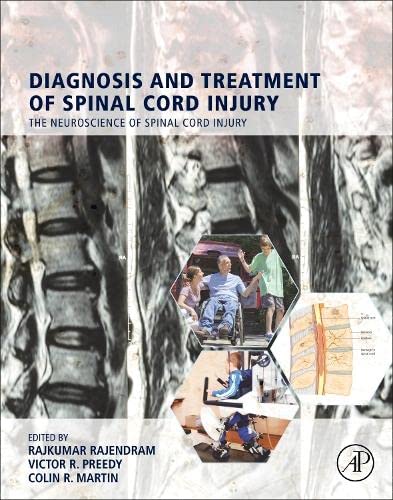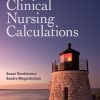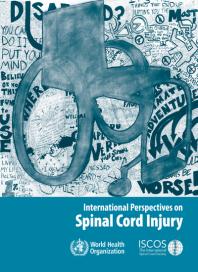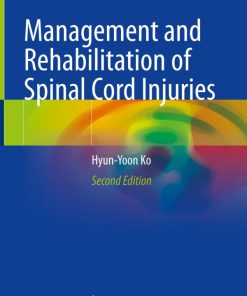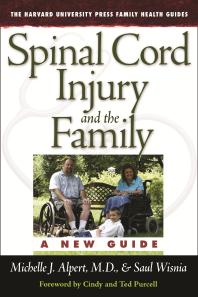Diagnosis and Treatment of Spinal Cord Injury 1st Edition by Rajkumar Rajendram 9780128224991 0128224991
$50.00 Original price was: $50.00.$25.00Current price is: $25.00.
Diagnosis and Treatment of Spinal Cord Injury 1st Edition Rajkumar Rajendram – Ebook Instant Download/Delivery ISBN(s): 9780128224991, 0128224991

Product details:
- ISBN 10: 0128224991
- ISBN 13:9780128224991
- Author: Rajkumar Rajendram
Diagnosis and Treatment of Spinal Cord Injury
Diagnosis and Treatment of Spinal Cord Injury will enhance readers’ understanding of the complexities of the diagnosis and management of spinal cord injuries. Featuring chapters on drug delivery, exercise, and rehabilitation, this volume discusses in detail the impact of the clinical features, diagnosis, management, and long-term prognosis of spinal cord injuries on the lives of those affected. The book has applicability for neuroscientists, neurologists, clinicians, and anyone working to better understand spinal cord injuries.
- Covers both the diagnosis and treatment of spinal cord injury
- Contains chapter abstracts, key facts, dictionary, and summary points to aid in understanding
- Features chapters on epidemiology and pain
- Includes MRI usage, biomarkers, and stem cell and gene therapy for management of spinal cord injury
- Discusses pain reduction, drug delivery, and rehabilitation
Table contents:
Section A: Setting the scene: Introductory chapters
Chapter 1: Traumatic spinal cord injury and outcomes in low-resource settings
Abstract
Introduction
Epidemiology
Etiology
Diagnosis
Prehospital and acute management
Treatment strategies
Post-acute medical care and rehabilitation
Applications to other areas of neuroscience
Key facts of global traumatic spinal cord injury epidemiology and etiology
Summary points
References
Chapter 2: Biomechanics and patterns of spine injuries associated with spinal cord injury
Abstract
Introduction
Pathogenesis of TSCI: The critical role of spine biomechanics
Patterns of spine injuries associated with spinal cord injuries
Applications to other areas of neuroscience
Mini-dictionary of terms
Key facts
Summary points
References
Chapter 3: Body, action, and space representations in people affected by spinal cord injuries
Abstract
Introduction
The neuroplasticity following SCI and the networks involved in the body, space, and action representations
The body representations
The action representation
The space representation
The effects of rehabilitation on the body, action, and space representations
Conclusions
Applications to other areas of neuroscience
Mini-dictionary of terms
Key facts of neuroplasticity following spinal cord injury
Summary points
References
Chapter 4: Methods for treating pain and painful syndromes in spinal cord injury: Medications, therapies, interventions, and neuromodulation
Abstract
Introduction
Application to other areas of neuroscience
Main narrative text
Mini-dictionary of terms
Key facts of pain after SCI
Summary points
References
Section B: Clinical features of spinal injury
Chapter 5: Factors contributing to pressure injuries in traumatic spinal cord injury
Abstract
Introduction
Pathophysiology of pressure injuries
Prevalence, impact, and cost of pressure injuries in patients with SCI
Structural and physiological changes following SCI
Risk assessment tools
Risk factors associated with pressure injuries in patients with traumatic spinal cord injury
Conclusion
Applications to other areas of neuroscience
Mini-dictionary of terms
Key facts of pressure injuries
Summary points
References
Chapter 6: Venous thromboembolism in spinal cord injury—Prophylaxis, diagnosis and treatment
Abstract
Introduction
Epidemiology
Screening
Prophylaxis
Diagnosis
Treatment
Conclusion
Applications to other areas of neuroscience
Mini-dictionary of terms
Key facts of venous thromboembolism in spinal cord injury
Summary points
References
Chapter 7: Osteoporosis-related fractures: What they are and how they occur following spinal cord injury
Abstract
Introduction
Physiopathology
Fractures
Risk factors
Diagnosis
Treatment
Conclusion
Applications to other areas of neuroscience
Mini-dictionary of terms
Key facts of osteoporosis after spinal cord injury
Key facts of fragility fractures after spinal cord injury
Key facts of diagnosis of osteoporosis after spinal cord injury
Key facts of treatment for osteoporosis-related fractures after spinal cord injury
Summary points
References
Chapter 8: Understanding the effects of prolonged cervical spinal cord compression on the brain. Current knowledge and future challenges
Abstract
Introduction
Cervical spine compression causes brain atrophy
Cervical spine compression causes neural plasticity to preserve function
Cervical spine compression changes the functional connectivity of the brain
Cervical spine compression also damages the brain WM
Conclusion and future perspectives
Applications to other areas of neuroscience
Mini-dictionary of terms
Key facts of spinal cord compression
Key facts of advanced MRI techniques
Summary points of cervical spine compression
References
Chapter 9: Spasticity in spinal cord injury
Abstract
Introduction
Pathophysiology of spasticity
Manifestations of spasticity in spinal injuries
Assessment of spasticity and its consequences
Treatment of spasticity
Modalities of treatment in spinal injury
Outcome measures after treatment
Management protocol for spasticity in spinal cord injury
Applications to other areas of neuroscience
Mini-dictionary of terms
Key facts of “diagnosis of spasticity in spinal cord injury”
Key facts of “treatment of spasticity in spinal cord injury”
Summary points
References
Chapter 10: Fall circumstances, consequences, assessments, and interventions to manage fall risk among individuals living with spinal cord injury
Abstract
Introduction
Fall frequency
Fall circumstances
Consequences of falls
Assessment of fall risk
Intervention program to manage fall risk
Application to other areas of neuroscience
Mini-dictionary of terms
Key facts of fall frequency and fall circumstances
Key facts of consequences of falls
Summary points
References
Chapter 11: Infections and spinal cord injury: Covid-19 and beyond
Abstract
Introduction
Immunosuppression due to spinal cord injury
Leading infection diseases in spinal cord-injured patients
COVID-19 disease: A new infectious normality in spinal cord-injured patients?
Key facts of “infections and spinal cord injury: Covid-19 and beyond”
Summary points
References
Chapter 12: Sleep problems in spinal cord injury
Abstract
Introduction
Sleep-disordered breathing
Prevalence of sleep-disordered breathing after tetraplegia
Sleep-disordered breathing is an acute and direct consequence of cervical SCI
Sleep-disordered breathing after tetraplegia has clinically important impacts
Why do people with tetraplegia have sleep-disordered breathing, predominantly obstructive sleep apnea?
Clinical management of sleep-disordered breathing in people with SCI
How does SCI alter the circadian rhythm?
Periodic leg movements of sleep in SCI
Applications to other areas of neuroscience
Mini-dictionary of terms
Key facts of sleep
Summary points
References
Further reading
Section C: Diagnosis and evaluation
Chapter 13: Biomarkers in spinal cord injury: A highlight on prognostic insights
Abstract
Acknowledgments
Introduction
Pathophysiology of SCI
Biomarkers of SCI
microRNAs as biomarkers
Exosomes
Conclusions
Mini-dictionary of terms
Key facts of biomarkers spinal cord injury
Summary points
References
Chapter 14: Quality of life tools for spinal cord–injured people
Abstract
Introduction
Definitions: Quality of life and health-related quality of life
Implementation in the study of quality of life in people with spinal cord injury
Integrative quality of life assessment instruments
Health-related quality of life assessment instruments for conditions resulting from spinal cord injury
Conclusions
Applications to other areas of neuroscience
Dictionary of terms
Key facts of measuring quality of life in sci people
Summary
References
Chapter 15: S100b in spinal cord injury
Abstract
Introduction
S100b characteristics
S100b and CNS pathology
Biomarkers in SCI
S100b and SCI
Limitations and perspectives
Applications to other areas of neuroscience
Mini-dictionary of terms
Key facts of calcium-binding proteins
Summary points
References
Chapter 16: Assessment of postural control after spinal cord injury or disease: A narrative review
Abstract
Introduction
Chapter objectives
Comprehensive assessment of postural control
Current state of postural control assessment in clinical settings
Instrumented assessments of postural control
Individualized and comprehensive assessment of postural control after SCI/D
Wheelchair users: Assessment of postural control
Part-time ambulators: Assessment of postural control
Full-time ambulators: Assessment of postural control
Summary
Applications to other areas of neuroscience
Mini-dictionary of terms
Key facts of postural control
Summary points
References
Section D: Treatments: Experimental and clinical
Chapter 17: Surgical management of acute spinal cord injury in emergency setting
Abstract
Introduction
Natural history of patients with acute cervical SCI
Natural history of patients with thoracic or thoracolumbar SCI
Surgical procedures
How to define early versus late surgery post SCI?
Which is the most efficacious threshold?
What threshold is feasible?
Does ESD offers the same benefit for all acute SCI?
Complete versus incomplete SCI
Effects of ESD on different neurological level of injury
The special case of Central Cord Syndrome
Conclusions
Applications to other areas of neuroscience
Mini-dictionary of terms
Key facts of surgical treatment of spinal cord injury
Summary points
References
Chapter 18: Spinal cord epidural stimulation for autonomic nervous system control: A focus on improving bladder, bowel, and cardiovascular function
Abstract
Introduction
Future directions with scES and applications to other areas of neuroscience
Mini-dictionary of terms
Key facts of autonomic dysfunction after SCI
Key facts of scES after SCI
Summary points
References
Chapter 19: Treating spinal cord injury with implanted spinal cord stimulators
Abstract
Introduction
Spinal cord stimulation
Spinal cord stimulators
Significance of SCS
Current limitations of the neurostimulators
Advanced neurostimulators
Prospects of the stimulation for spinal cord injury rehabilitation
Applications to other areas of neuroscience
Mini-dictionary of terms
Key facts of spinal cord injury
Summary points
References
Chapter 20: Bowel dysfunction in spinal cord injury
Abstract
Introduction
Characteristics of neurogenic bowel in spinal cord injury
Clinical manifestations
Diagnosis
Conservative treatment of the neurogenic bowel
Surgical treatment of the neurogenic bowel
Conclusions
Applications to other areas of neuroscience
Dictionary of terms
Key facts of neurogenic bowel dysfunction
Summary points
References
Chapter 21: Management of neurogenic lower urinary tract dysfunction due to spinal cord injury
Abstract
Introduction
Physiology of storage and emptying
Pathophysiology of NLUTD due to SCI
Overview of management of patients with NLUTD due to SCI
Basic and optional assessments
Urinary management (Table 3)
Pharmacological treatment
Assessment of clinical outcomes (periodic follow-up)
Surgical treatment
Applications to other areas of neuroscience
Mini-dictionary of terms
Key facts of catheters for clean intermittent catheterization
Summary points
References
Chapter 22: Bed support surfaces for preventing pressure injuries after spinal cord injury
Abstract
Introduction
Pressure injuries (PI): Definition, epidemiology and impacts
Pathogenesis of pressure injuries following spinal cord injury
Support surfaces: An approach for prevention and treatment of pressure injuries
Conclusion
Applications to other areas of neuroscience
Mini-dictionary of terms
Key facts of pressure injuries after spinal cord injury
Summary points
References
Chapter 23: Nerve and tendon transfers in tetraplegia: A new narrative
Abstract
Introduction
Classifications
Indications and timing
People also search:
diagnosis and treatment of spinal cord injury
acute spinal cord injury symptoms
t9 spinal cord injury symptoms
how to diagnose spinal cord injury
suspected spinal injury symptoms
You may also like…
Medicine - Neurology
Medicine - Surgery
Color Atlas of Spinal Cord Surgery by Jörg 9783030899646 3030899640
Relationships & Lifestyle - Diet & Nutrition
Uncategorized
International Perspectives on Spinal Cord Injury 1st Edition World Health Organization
Medicine - Anatomy and physiology
Management and Rehabilitation of Spinal Cord Injuries 2nd Edition Hyun-Yoon Ko
Uncategorized
Medicine - Anatomy and physiology

